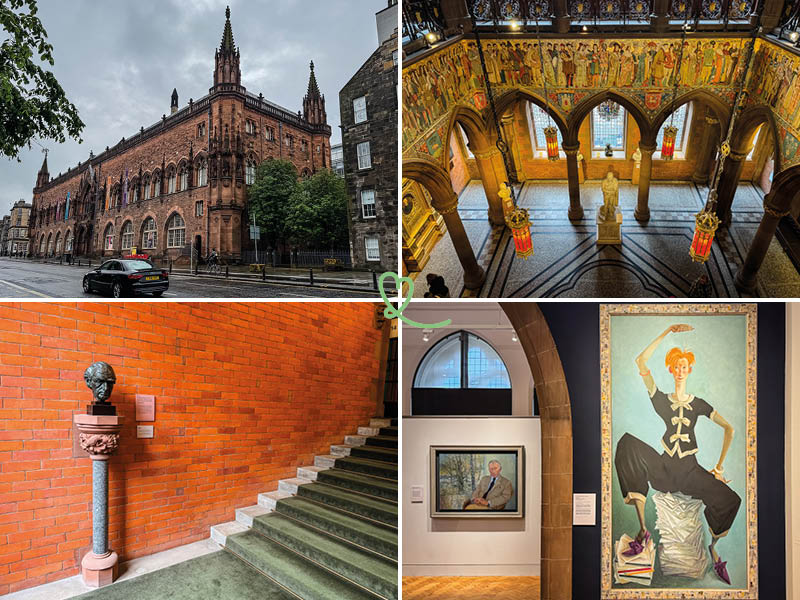The Scottish National Portrait Gallery in Edinburgh immersed us in Scottish history and culture through a rich collection of portraits. From the moment we entered, the imposingneo-Gothic architecture and vast entrance hall set the tone for our visit.
Throughout the galleries, we discovered the faces that have shaped the country’s identity, from royal figures to contemporary personalities. The permanent and temporary exhibitions gave us an insight into the role of portraiture in the construction of Scotland’s national narrative.
In this article, you’ll find some useful tips to help you prepare for your visit and have a wonderful time!

This opinion is completely independent, based on our experiences. We visited the region anonymously, making our own choices and paying our bills in full.
Why visit the Scottish National Portrait Gallery
Is the museum worth it? Our opinion:
Yes, absolutely! It’s one of our favorite things to do in Edinburgh. To visit the Scottish National Portrait Gallery is to immerse yourself in Scottish history and culture through the people who shaped it. Here, in our opinion, are three reasons why a visit is a must:
- A remarkable building: the neo-Gothic architecture in red sandstone, the frescoes in the entrance hall and the layout of the rooms provide an impressive setting for a visit.
- A unique collection: from royal figures to contemporary personalities, the portraits on display tell the story of the evolution of Scottish identity over the centuries.
- Exhibitions that question history: Between permanent exhibitions and engaging temporary shows, the gallery offers a dynamic and critical look at Scotland’s past and present.

Why is the Scottish National Portrait Gallery famous?
The Scottish National Portrait Gallery is famous for its unique collection of portraits tracing the history of Scotland through its iconic figures. Housed in an imposing neo-Gothic building, the gallery showcases key figures, writers, artists, scientists and politicians, from Mary Stuart to Tilda Swinton. Its exhibitions, mixing classical and contemporary works, offer a fascinating insight into theScottish identity.

Our favorite moments
- On our visit, we were immediately struck by the building’s imposing neo-Gothic architecture and Great Hall. Under the frescoed vaults, light filters through the stained glass windows, creating a solemn atmosphere where Scottish history seems to come alive.
- We also liked the library, a hushed space that contrasts with the vast galleries. With its archives and antiquarian works, it offers a fascinating glimpse into the past of the figures on display.
- Finally, we appreciated the diversity of media used to depict Scottish faces. The juxtaposition of paintings, photographs and sculptures enriches the reading of the portraits and shows how the art of portraiture has evolved over the centuries.

WHERE TO STAY IN Edinburgh
Our favorites: neighborhoods and hotels
Our selection is coming soon Hotel 1 – See prices, photos and availability
Our selection is coming soon Hotel 1 – See prices, photos and availability
Our selection is coming soon Hotel 1 – See prices, photos and availability

See our complete selection of the best hotels in Edinburgh (coming soon)
History in brief
The Scottish National Portrait Gallery opened in Edinburgh in 1889, becoming the world’s first museum dedicated exclusively to portraits. Designed by architect Robert Rowand Anderson, its imposing neo-Gothic red sandstone façade reflects his ambition to celebrateScottish identity. The collection, initially focused on historical figures, has expanded to include contemporary personalities. Today, the museum combines paintings, photographs and sculptures to explore the country’s history through its faces.

Access: Scottish National Portrait Gallery, Edinburgh
Where is the Scottish National Portrait Gallery?
- InEdinburgh city center, in the New Town district
- Near St Andrew Square
The museum’s address is as follows:
1 Queen Street, Edinburgh, EH2 1JD, Scotland

RENT YOUR CAR IN Scotland
- Compare prices on our preferred platform: DiscoverCars – one of the best rated sites.
- Choose a car that’s not too wide, as some roads have only one lane.
- Book early for choice.

See our tips (coming soon)
How to get there?
- By car: As the museum is in the city center, parking is limited.
- On foot: From Princes Street, it’s about a 5-minute walk up Queen Street. Easy access from all major city center attractions.
- By public transport: The Dublin Street bus stop is directly opposite the museum.Edinburgh Waverley station is a 10-minute walk away.
- By bike: The surrounding streets are accessible to cyclists, with some slight inclines.

Parking
Parking near the Scottish National Portrait Gallery can be a challenge due to its city-center location.
- There are several pay parking lots nearby, such as the Q-Park Omni Centre and the St James Quarter Car Park, both of which can be reached on foot in less than 10 minutes.
- Street parking is limited and subject to time restrictions.
discover edinburgh
- What to do in Edinburgh (coming soon)
- Best hotels (coming soon)
- Best restaurants (coming soon)

Useful tips: duration, schedules, eating…
Best time to visit
We advise you to visit the Scottish National Portrait Gallery during the week, in the morning or late afternoon, to avoid the crowds. Weekends and bank holidays attract more visitors, especially for temporary exhibitions. The natural light streaming through the stained-glass windows of the Great Hall adds a special atmosphere at the start of the day. In winter, a visit in the late afternoon allows you to enjoy a more hushed, intimate atmosphere in the galleries.

Length of visit and main difficulties
- A visit to the Scottish National Portrait Gallery lasts between 1h30 and 2 hours, depending on the level of interest in the works.
- The main difficulty was the sheer volume of information, which we found to be dense.
- Last but not least, access can be complicated by narrow staircases and passageways, but an elevator is available for people with reduced mobility.

Advice on how to visit
We began our visit in the Great Hall, where frescoes and sculptures introduce Scottish history. We headed straight up to the second floor to view portraits of historical figures, before discovering contemporary portraits and the temporary exhibition on the second floor. The latter, a photo exhibition, was dedicated to the legacy of coal, Before & After the Coal.

PLAN YOUR DREAM TRIP AROUND scotland
All the information you need for your trip:
- 15 maps for easy planning
- + 170 pre-selected locations
- Practical advice
- + 170 photos to help you choose

Visiting with children
- Visiting the Scottish National Portrait Gallery with children can be an enriching experience, thanks to the captivating portraits and varied settings.
- Certain exhibits, especially photographs and sculptures, may be of particular interest to visitors.
- We noticed that activity booklets were available to make discovery more interactive.
- However, the itinerary can seem dense for younger visitors, so it’s best to allow for breaks, especially in the Great Hall, library, museum store or café.
- More info here

Schedules and rates
- The Scottish National Portrait Gallery is open daily from 10am to 5pm.
- It is closed on December 25 and 26, and opens at noon on January 1.
- Admission to permanent exhibitions is free.
- Some temporary exhibitions may be subject to a charge.
- Find out more here.

Guided tours
The Scottish National Portrait Gallery offers audio guides to enhance your visit. These guides provide detailed commentary on the works and artists. They are available via the Smartify app.
Catering
- We found Le Café Portrait inside the Scottish National Portrait Gallery. It’s set in a bright room with red stone arches. It’s a pleasant setting for a break during your visit.
- You’ll find homemade dishes, pastries and vegetarian options.
- The café is open from 10 a.m. to 5 p.m., and requires no admission ticket.

Immerse yourself in an exceptional setting
From the moment we arrived, the museum’s imposing architecture seemed to herald an extraordinary visit. Far from being a mere exhibition space, the place itself already tells the story of Scotland.
A remarkable neo-Gothic building
The red sandstone building, designed by Robert Rowand Anderson and inaugurated in 1889, immediately caught our eye. Inspired by medieval Gothic architecture, it features a richly sculpted facade, depicting Scottish historical figures. Its ornamental details, slender spires and ogee windows give it a unique presence that evokes the importance of Scotland’s heritage.

A monumental hall full of symbols
As we passed through the doors, we discovered the vast central hall with its frescoed walls. This great hall, bathed in light, presents Scottish history through a panoramic fresco of emblematic figures. The massive columns and the layout of the hall accentuate the feeling of grandeur and reinforce the solemn character of the place.

A captivating journey through the faces of history
The museum invites us to cross the centuries and discover the faces that have marked Scottish history. Each space reveals a particular aspect of portraiture, from sculpture to classical paintings.
Sculptures that bring staircases to life
On our way up to the upper floors, we came across a series of sculptures, heads and busts that line the staircases. They provide a fluid transition between the different sections of the museum.

Historical portraits through the ages
We went straight to the second floor to enjoy a chronology of Scottish portraits, from monarchs to influential thinkers. Through the works, we were also able to observe the evolution of artistic styles and codes of representation.

The painted faces of past centuries bear witness to both the grandeur and the tensions of an era. They reveal both the official image and the political realities of each period.

“Heroes & Heroines, iconic personalities
This section celebrates figures who have left their mark on Scottish history: sovereigns and social and cultural leaders. Each portrait tells the story of a commitment, a struggle or a contribution to national identity. The exhibition is designed to provide a nuanced perspective. It combines historical recognition with reflection on the impact of these personalities on the collective memory.

A look at tradition and modernity
While the museum celebrates figures from the past, we also appreciated the focus on contemporary perspectives. Paintings, photographs and modern installations reinterpret portraiture as a living, constantly evolving art form.
A space dedicated to contemporary portraiture
In this section, we were able to admire modern portraits, sometimes abstract or deconstructed, that question classical representations. Techniques range from large-format photography to digital painting. The emphasis is on the diversity of personalities and stories, reflecting a Scotland on the move and open to the world.

The cozy space of the library
You won’t want to miss the library and its intimate atmosphere. Here we found archives, antiquarian works and studies on the figures on display. The studious atmosphere of the library allows you to delve deeper into thehistory of portraiture and its evolution. Between the book-laden shelves, the library offers an invaluable break from exploring the museum.

Committed, immersive contemporary exhibitions
Temporary exhibitions constantly renew the museum experience. At the time of our visit, Before & After the Coal featured a series of photographic portraits capturing the legacy of Scotland’s mining communities. These thematic exhibitions take a critical look at societal issues, and offer a current, engaged reading of portraiture as a reflection of an era.

Subscribe to our Newsletter
- Get away from it all with Region Lovers’ beautiful destinations!
- Once a month
- Advertising-free
Frequently asked questions
Is it possible to stay overnight in the Scottish National Portrait Gallery?
Unfortunately not. The museum is only open during the day. However, special evening events may be organized, such as lectures or themed tours. For a night-time experience, please consult the museum program.




